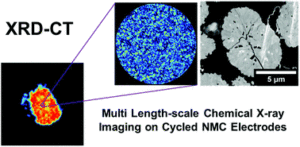Our latest work on the characterisation of NMC electodes used in Li-ion batteries at the PCCP published
Our latest work on the characterisation of NMC electodes used in Li-ion batteries at the PCCP has been published in a new paper, “Exploring cycling induced crystallographic change in NMC with X-ray diffraction computed tomography” in the journal Physical Chemistry Chemical Physics.
The research was carried out in collaboration with the Electrochemical Innovation Lab (EIL) from the UCL Chemical Engineering, Johnson Matthey, the Faraday Institution, NREL, UCL Chemistry and ESRF.
This study presents the application of X-ray diffraction computed tomography for the first time to analyze the crystal dimensions of LiNi0.33Mn0.33Co0.33O2 electrodes cycled to 4.2 and 4.7 V in full cells with graphite as negative electrodes at 1 μm spatial resolution to determine the change in unit cell dimensions as a result of electrochemical cycling. The nature of the technique permits the spatial localization of the diffraction information in 3D and mapping of heterogeneities from the electrode to the particle level. An overall decrease of 0.4% and 0.6% was observed for the unit cell volume after 100 cycles for the electrodes cycled to 4.2 and 4.7 V. Additionally, focused ion beam-scanning electron microscope cross-sections indicate extensive particle cracking as a function of upper cut-off voltage, further confirming that severe cycling stresses exacerbate degradation. Finally, the technique facilitates the detection of parts of the electrode that have inhomogeneous lattice parameters that deviate from the bulk of the sample, further highlighting the effectiveness of the technique as a diagnostic tool, bridging the gap between crystal structure and electrochemical performance.
Read the full article at https://doi.org/10.1039/D0CP01851A

